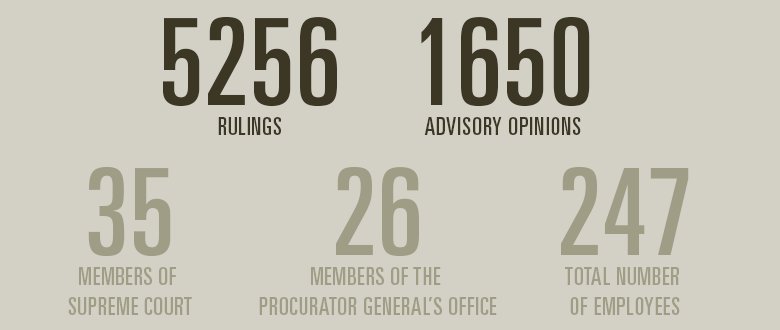Introduction
With this annual report, the Supreme Court of the Netherlands and the Procurator General’s office publicly account for their work and use of resources in 2019.
The annual report discusses developments in 2019. A number of themes are discussed in the 2019 Highlights section. A brief summary of 2019 will be presented first. Next the spotlight will be directed at the Supreme Court’s position in our State under the rule of law and its three key duties: offering protection of individual rights, ensuring uniformity of law and contributing to the development of law. The last duty in particular receives extensive attention nowadays. But how does this key duty relate to another key duty: the protection of individual rights? This is discussed in more detail under ‘Key Duties of the Supreme Court’. The Supreme Court’s relationship and contact with the legislature is also discussed, specifically under ‘Contact with the Legislature’. There, the rulings with which the Supreme Court intended to send a signal to the legislature in 2019 are also explained. The last section in 2019 Highlights concerns the Supreme Court’s contact with the public. There, the manner in which the Supreme Court informs and communicates with the public is explained. Since its establishment in 1838, the Supreme Court has been one of the authoritative institutions within our democracy under the rule of law in peacetime. The duty of pronouncing justice is part of this system of our society, making it a public duty. The duty that has essentially remained the same since 1838 is that of court in cassation. Over time, however, the Supreme Court’s form and substance have been subjected to changes, including as a result of changes in society. Nowadays, authority is not an unquestionable asset. Authority must always be earned, maintained and retained. In order to continue to properly perform its public duty on the one hand while remaining an authoritative institution on the other, the Supreme Court must remain, and must aim to remain – visibly, ascertainably and recognisably – in the midst of society. By all means, it must maintain its high judicial standards while doing so. In recent years, communication with the public has become more intense. How the Supreme Court handles this is explained in detail under ‘Contact with the Public’.
In addition, several cases in which the Supreme Court gave judgments in the past year that were key to developing the law are discussed, by discipline, in this annual report. These can be found under the sections on the three divisions.
The annual report also discusses the Procurator General of the Supreme Court. The most important task of the Procurator General’s office is to issue reports prepared with scholarly substantiation, referred to as ‘advisory opinions’, regarding cases being heard by the Supreme Court. These are issued completely independently by the advocates general of that office. By lodging an appeal in cassation in the interest of the law, the Procurator General of the Supreme Court can also create an opportunity for the Supreme Court to promote uniformity of law without litigants having to institute proceedings in cassation. That opportunity has been used more intensively in recent years than it was in the past. This is discussed under the heading ‘Procurator General’s Office’, where attention is also devoted to the special duties of the Procurator General.
Finally, this annual report addresses internal and external complaints and the figures for 2019.
